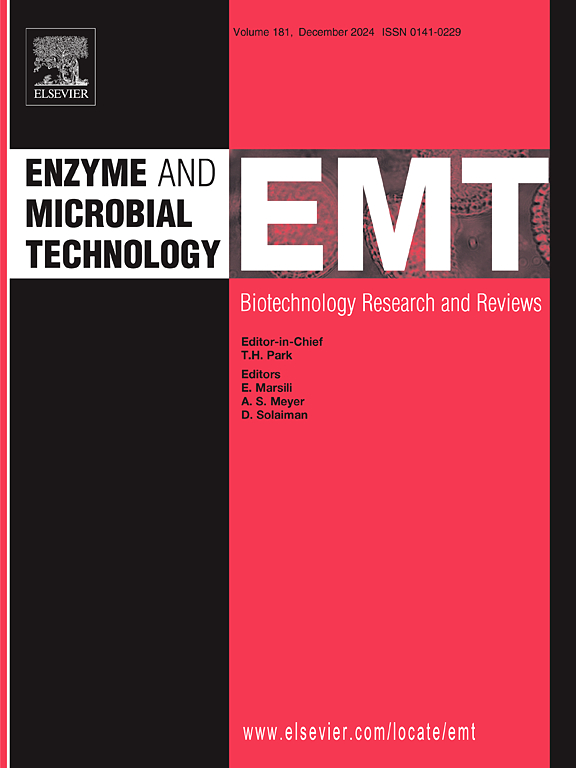半合理工程的3-酮类固醇-Δ1-dehydrogenase提高催化效率和稳健性类固醇生物转化
IF 3.7
3区 生物学
Q2 BIOTECHNOLOGY & APPLIED MICROBIOLOGY
引用次数: 0
摘要
甾体药物在临床治疗中发挥着关键作用,androsta-1,4-二烯-3,17-二酮(ADD)作为关键中间体,其有效的生物合成依赖于3-酮类固醇-Δ1-dehydrogenase (KstD)的催化活性。在先前设计的KstD2ep变体的基础上,本研究采用半合理的设计策略来增强KstD2的高底物负载适应性。通过同源建模和分子对接,系统鉴定关键残基V332、L334、G534,构建组合突变文库。通过丙氨酸扫描和单/多位点突变的迭代筛选,最优突变体KstD2ep (V332E/L334T/G534V)的催化效率比KstD2ep提高了1.1倍。分子动力学模拟证实突变体的结构稳定性显著增强。全细胞催化优化揭示了对温度波动、pH变化和共溶剂暴露的扩展操作耐受性。通过高密度发酵加上补料批底物的补充,该工艺将底物转化效率提高了1.5倍,产生117.75 g/L ADD。这些进展使该工程变体成为可扩展类固醇生物转化的高潜力候选物,解决了酶驱动类固醇药物中间体生物合成的酶稳定性和工艺效率的关键障碍。本文章由计算机程序翻译,如有差异,请以英文原文为准。
Semi-rational engineering of 3-Ketosteroid-Δ1-dehydrogenase boosts catalytic efficiency and robustness for steroid bioconversion
Steroid drugs play a pivotal role in clinical therapeutics, with androsta-1,4-diene-3,17-dione (ADD) serving as a critical intermediate whose efficient biosynthesis relies on the catalytic activity of 3-ketosteroid-Δ1-dehydrogenase (KstD). Building upon the previously engineered KstD2ep variant, this study employed semi-rational design strategies to enhance KstD2’s high-substrate-loading adaptability. Key residues (V332, L334, G534) were systematically identified through homology modeling and molecular docking, followed by constructing a combinatorial mutant library. Through alanine scanning and iterative screening of single/multiple-site mutations, the optimal mutant KstD2ep (V332E/L334T/G534V) demonstrated a 1.1-fold enhancement in catalytic efficiency compared to the KstD2ep. Molecular dynamics simulations confirmed significantly enhanced structural stability in the mutant. Whole-cell catalytic optimization revealed expanded operational tolerance to temperature fluctuations, pH variations, and co-solvent exposure. Implementing high-density fermentation coupled with fed-batch substrate supplementation, the process achieved a 1.5-fold increase in substrate conversion efficiency, yielding 117.75 g/L ADD. These advancements position the engineered variant as a high-potential candidate for scalable steroid biotransformation, addressing key barriers to enzymatic stability and process efficiency for enzyme-driven biosynthesis of steroidal pharmaceutical intermediates.
求助全文
通过发布文献求助,成功后即可免费获取论文全文。
去求助
来源期刊

Enzyme and Microbial Technology
生物-生物工程与应用微生物
CiteScore
7.60
自引率
5.90%
发文量
142
审稿时长
38 days
期刊介绍:
Enzyme and Microbial Technology is an international, peer-reviewed journal publishing original research and reviews, of biotechnological significance and novelty, on basic and applied aspects of the science and technology of processes involving the use of enzymes, micro-organisms, animal cells and plant cells.
We especially encourage submissions on:
Biocatalysis and the use of Directed Evolution in Synthetic Biology and Biotechnology
Biotechnological Production of New Bioactive Molecules, Biomaterials, Biopharmaceuticals, and Biofuels
New Imaging Techniques and Biosensors, especially as applicable to Healthcare and Systems Biology
New Biotechnological Approaches in Genomics, Proteomics and Metabolomics
Metabolic Engineering, Biomolecular Engineering and Nanobiotechnology
Manuscripts which report isolation, purification, immobilization or utilization of organisms or enzymes which are already well-described in the literature are not suitable for publication in EMT, unless their primary purpose is to report significant new findings or approaches which are of broad biotechnological importance. Similarly, manuscripts which report optimization studies on well-established processes are inappropriate. EMT does not accept papers dealing with mathematical modeling unless they report significant, new experimental data.
 求助内容:
求助内容: 应助结果提醒方式:
应助结果提醒方式:


